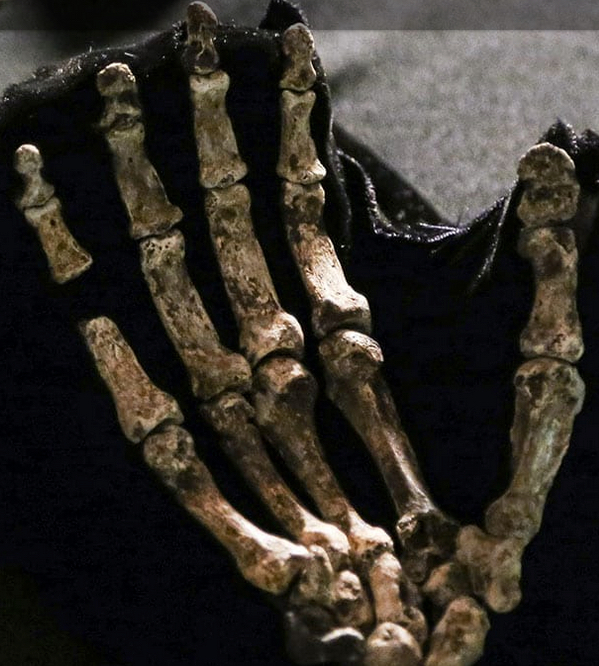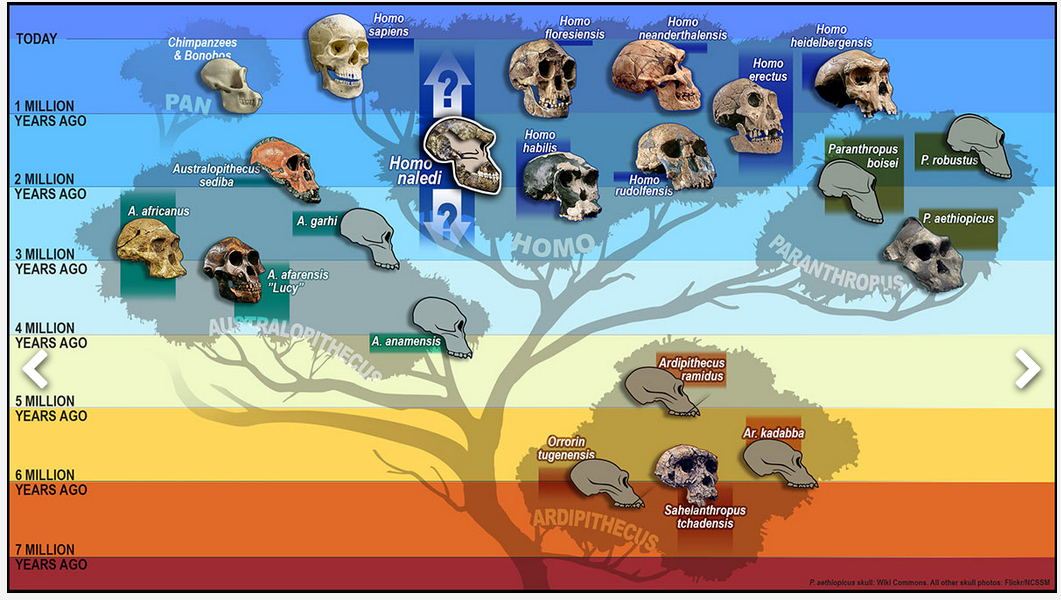Discovery of Homo naledi adds a new branch to the human family tree
September 11, 2015

Skeletal fossil of the hand of Homo naledi (photo credit: John Hawks, UW–Madison)
An international research team has discovered a new species of a human relative, Homo naledi, uncovered in a cave outside of Johannesburg, South Africa. The discovery in late 2013 may shed light on the diversity of our genus and possibly its origin.
The team’s findings, which are published in two papers in the open-access journal eLife, were announced by South Africa’s University of the Witwatersrand, the National Geographic Society, and the South African National Research Foundation.

Homo naledi: A New Species on the Human Family Tree (illustration credit: S.V. Medaris/UW-Madison)
The authors describe Homo naledi as being similar in size and weight to a small modern human, with human-like hands and feet. The skull had a small braincase “similar in size to other early hominin species that lived between four million and two million years ago.”
The discovery indicates that H. naledi intentionally deposited bodies of its dead in a remote cave chamber — behaviors previously thought limited to humans.

This figure includes the 737 partial or complete anatomical elements of Homo naledi found (credit: Lee R. Berger et al./eLife)
Lee Berger, a research professor in the Evolutionary Studies Institute at the University of the Witwatersrand and a National Geographic Explorer-in-Residence, led the expeditions that recovered the fossils — more than 1,500 bones belonging to at least 15 individuals.
The National Geographic article “This Face Changes the Human Story. But How?” offers striking art and photography on this discovery.
University of Wisconsin-Madison | Meet our newest ancestor: Homo naledi
Abstract of Homo naledi, a new species of the genus Homo from the Dinaledi Chamber, South Africa
Homo naledi is a previously-unknown species of extinct hominin discovered within the Dinaledi Chamber of the Rising Star cave system, Cradle of Humankind, South Africa. This species is characterized by body mass and stature similar to small-bodied human populations but a small endocranial volume similar to australopiths. Cranial morphology of H. naledi is unique, but most similar to early Homo species including Homo erectus, Homo habilis orHomo rudolfensis. While primitive, the dentition is generally small and simple in occlusal morphology. H. naledi has humanlike manipulatory adaptations of the hand and wrist. It also exhibits a humanlike foot and lower limb. These humanlike aspects are contrasted in the postcrania with a more primitive or australopith-like trunk, shoulder, pelvis and proximal femur. Representing at least 15 individuals with most skeletal elements repeated multiple times, this is the largest assemblage of a single species of hominins yet discovered in Africa.
Abstract of Geological and taphonomic context for the new hominin species Homo naledi from the Dinaledi Chamber, South Africa
We describe the physical context of the Dinaledi Chamber within the Rising Star cave, South Africa, which contains the fossils of Homo naledi. Approximately 1550 specimens of hominin remains have been recovered from at least 15 individuals, representing a small portion of the total fossil content. Macro-vertebrate fossils are exclusively H. naledi, and occur within clay-rich sediments derived from in situ weathering, and exogenous clay and silt, which entered the chamber through fractures that prevented passage of coarser-grained material. The chamber was always in the dark zone, and not accessible to non-hominins. Bone taphonomy indicates that hominin individuals reached the chamber complete, with disarticulation occurring during/after deposition. Hominins accumulated over time as older laminated mudstone units and sediment along the cave floor were eroded. Preliminary evidence is consistent with deliberate body disposal in a single location, by a hominin species other than Homo sapiens, at an as-yet unknown date.